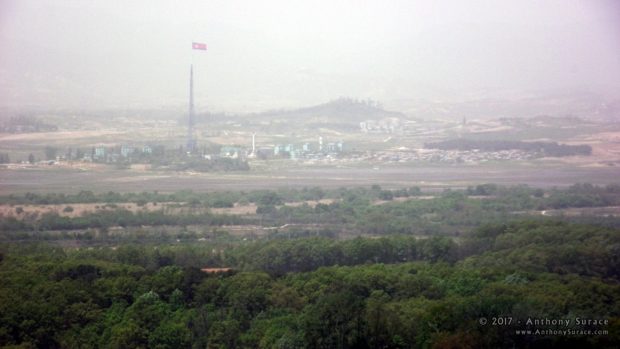
A view of North Korea‘s Kaesong City from the South Korean side of the demilitarized zone (Flickr – Anthony Surace via The Korea Herald/Asia News Network)
SEOUL — The Lunar New Year or Seollal is one of the two most important and celebrated traditional holidays in South Korea.
But, though both halves of the peninsula share many aspects of culture, nearly 77 years of division between the two Koreas have led to divergent holiday traditions.
In North Korea, the significance of socialist holidays, including the birth anniversaries of the late leaders Kim Il-sung and Kim Jong-il, the national foundation day on Sept. 9, and the party foundation day on Oct. 10, far outweighs traditional holidays.
So how do North Korean people welcome the Year of the Tiger?
Not surprisingly, North Koreans begin celebrating the Lunar New Year’s day by showing their loyalty to the Kim family. And later in the day, people observe ancestral rites, enjoy family meals, and watch art performances embedded with messages praising the preeminence of leader Kim Jong-un and the ruling party’s leadership.
In the morning, North Korean people lay flowers and pay respect to the statues or the portraits of the late North Korean leaders, Kim Il-sung and Kim Jong-Il.
Pyongyang residents visit the Kumsusan Palace of the Sun where the embalmed bodies of Kim Il-sung and Kim Jong-il are enshrined, and climb up Mansu Hill to bow down to giant bronze statues of the late leaders.
But there is no mass movement to visit family in North Korea, mainly as there is no freedom of movement. The scene is quite a contrast to its neighbor China, where the world’s largest annual migration usually takes place across the country each Lunar New Year.
North Korean people are required to have a travel permit to travel outside their residence. In addition, the Kim Jong-un regime strengthened restrictions on domestic travel in the name of preventing and controlling outbreaks of COVID-19.
Rather, North Korean people quietly celebrate the Lunar New Year, watching art performances including music concerts, “revolutionary operas,” and circuses held in each region, according to the previous state media reports.
The country’s leader Kim Jong-un is no exception. For the last two years, Kim and his staunch aides watched a celebratory concert filled with songs and performances that chanted the eulogy of the greatness of the ruling Workers’ Party of Korea and the North Korean leader, and envisioned a socialist utopia.
The songs such as “We Will Go Along the Road of Loyalty,” and “We‘ll Travel One Road Forever” resonated in the concert hall, the state-run Korean Central News Agency (KCNA) reported last January.
“The audience keenly felt once again the truth that our country and people have (an) immensely bright future despite whatever hardship and difficulties in the road of advance(ment) as long as the General Secretary leads the Party.”
Unlike South Korea, North Korean people still put a premium on New Year’s Day as the late founder Kim Il-sung disregarded the custom of celebrating the Lunar New Year as a “vestige of a feudal society” and designated the solar calendar’s New Year’s Day as an official holiday in 1946.
After the Korean War in 1953, the Lunar New Year tradition had disappeared without a trace.
But the late leader Kim Jong-il in 2003 instructed people to celebrate the 3-day Lunar New Year holidays instead of New Year’s Day, as part of his sweeping ideological campaign to promote the “Korean Nation-First Spirit.”
The Kim Jong-il regime accentuated the significance of the Lunar New Year as the traditional holiday of inheriting the national tradition.
Against that backdrop, North Korean people still enjoy traditional folk games including kite flying, top-spinning, jegichagi, and the yunnori board game during the Lunar New Year’s holidays.
This year’s calendar shows that North Korea has designated one public holiday for the Lunar New Year. People take a day off on the day, but they should make up the time by additionally working on Sundays, according to a database provided by South Korea’s Unification Ministry.
But people would still anticipate the Lunar New Year, as the Kim Jong-un regime has provided food and daily necessities on public holidays.
RELATED STORIES
Year of the Tiger: Things you need to know about it
Making tteokguk gets trendy in pandemic times
N. Korea caps month of tests with longest-range missile since 2017